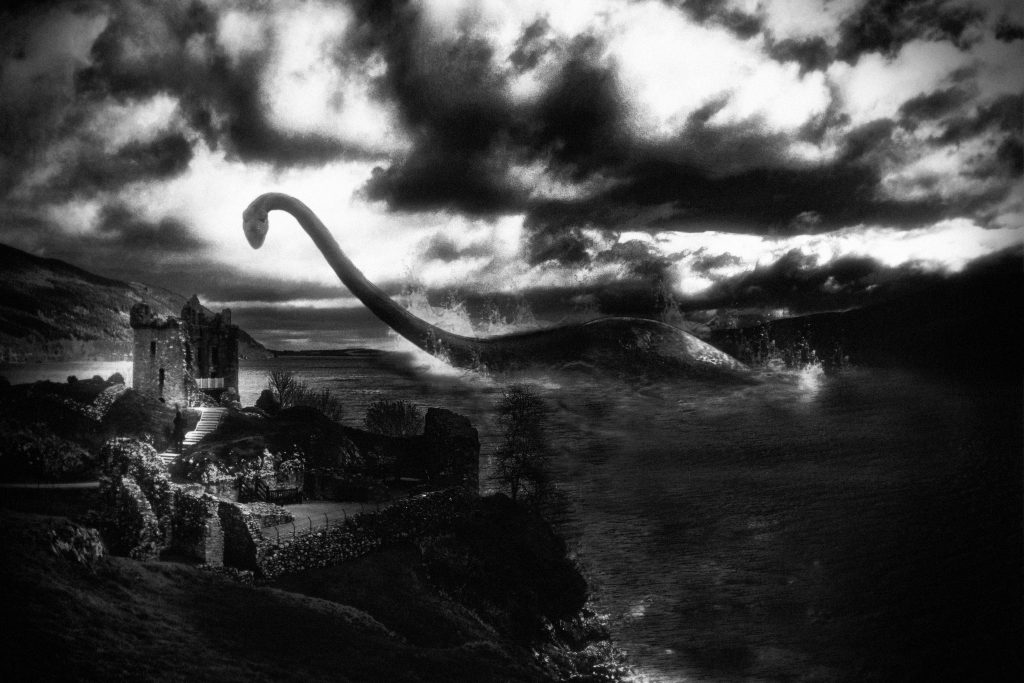
In May 2018, Professor Neil Gemmell made an announcement. He would be setting out on an expedition to take eDNA samples from Loch Ness. It just so happens that Loch Ness is host to one of the world’s famous cryptids, the Loch Ness Monster. Almost a year later, after he and his crew analyzed the samples, he came to a conclusion: one of the theories about the monster seemed very plausible.1

For the year 2017, sightings of the Loch Ness Monster, affectionately called Nessie, had been virtually nonexistent. This led to a decrease in popularity for the cryptid, making the chance of sighting the monster even less likely. For Gary Campbell, keeper of the official Loch Ness Monster Registrar, the fact that there was a significant lack of activity from Nessie, he says, was strange, as Nessie is “normally very active, and not at all camera-shy.”2 If this pattern continued, that could only mean two things, neither of which were particularly favorable: one, the population of whatever species Nessie hails from has decreased significantly enough within the loch that they decided to remain in hiding from humans, or two, Nessie was dead. If the former, then the chances of humanity ever proving her existence would become almost nil, and her legacy will be forgotten, chalked up as a joke. The same holds true for the latter, but for the avid Nessie fan, such as Campbell, the thought of her death or her species going extinct is just heartbreaking, like losing a beloved family member. Fortunately, the possibility of Nessie being dead could be put aside because one woman, Hayley Johnson, reported having seen Nessie later that year. Unsurprisingly, it’s just testimony; there’s no picture or video of the cryptid to go along with her report. Furthermore, reported sightings are nothing new—Campbell records around a dozen reported sightings annually, but much more make it to his office. With the search for Nessie having a history of hoax evidence, if humanity is ever to find anything conclusive about the monster, they would need something more than sightings. Something more than trying to catch Nessie herself. Something more scientific.3
In comes Neil Gemmell, professor and geneticist at the University of Otago in New Zealand. As the title implies, a Prof. Gemmell is someone who studies genetics; this time, what he would be studying is environmental DNA (eDNA). The grounds for testing? Loch Ness. So the next year, in May 2018, Prof. Gemmell announced to the public that he would be going out on a expedition to do two things: test the abilities of eDNA, and test “hypotheses about whether or not there’s this giant, scaly, reptilian creature that people claim they’ve seen” with the help of eDNA.4 The idea is, if Nessie is supposedly alive swimming in Loch Ness, then as a living organism, she should have cells that contain her DNA. With eDNA, scientists won’t have to extract this DNA from the monster herself. They can extract the DNA from her natural environment, Loch Ness, instead. To illustrate, say you have a pot of dirt that contains an earthworm. After a few weeks, you remove the earthworm but you keep the dirt. As long as there’s body fluids (saliva) or body waste (molts or fecal matter) left, which is highly likely, then the DNA of the earthworm can be extracted from the dirt and not the worm itself. As Nessie is a sea creature, her bodily fluids and waste should be floating in the loch; with eDNA, all Prof. Gemmell would need to do is take deep water samples, analyze the samples, and compare the DNA sequences found with known DNA sequences.5
When Adrian Shine, someone who has studied the biodiversity within Loch Ness for about four decades, caught wind of Prof. Gemmell’s expedition, he was more than happy to help. Before, Shine and his coworkers had been catching fish in nets, getting cultures from the fish and looking at them through a microscope, then making species lists of the things they had caught. So when confronted with the prospect of using eDNA to make more comprehensive species lists, he was impressed by how little water he would need to do this and how much simpler it is compared to what he was doing before, calling the use of eDNA a “new elegant method.”6
Already, Prof. Gemmell’s plan to spread the merits of eDNA through the Loch Ness Monster campaign was taking effect. So the next month, Prof. Gemmell met the rest of his team in person, Shine included, and they set off to take the water samples at depths of 50, 100, and 200 meters (about 164, 328, and 656 feet, respectively). After that, they took the samples to the lab provided by Shine to analyze the cells dispersed throughout the water samples they took and their DNA. After nearly a year of analyzing the DNA, Prof. Gemmell had a press conference. During that press conference, he concluded that there was no reptilian DNA found in the loch. With this, the popular belief that Nessie is some giant reptile living in Loch Ness is no longer convincing.7
However, this wasn’t the debunking of Nessie herself. Instead of leaving fans of the cryptid without hope, Prof. Gemmell fanned the embers once more; there existed one other theory that explained Nessie’s existence in a way that doesn’t portray her as being part-reptile that he believed to be very plausible.8

It turns out there was a shocking amount of eel DNA found in Loch Ness, which Prof. Gemmell made the highlight of his expedition.9 As such, it can safely be interpreted that he believes the Loch Ness Monster could really be a giant eel, or that he finds this explanation to be the most credible. Interestingly, the theory about the eel is older than Nessie’s initial rise to stardom, initiated in 1934 when a photograph known as the Surgeon’s Photo was taken of Christian Spurling’s fake model of Nessie and brought to the public’s attention. A year earlier, a Daily Mirror newspaper had “The Monster of Loch Ness Official! Orders That Nobody is to Attack It – A Huge Eel?” as its headline.10 Furthermore, about 20% of the DNA found in the Loch Ness waters couldn’t be identified, so there’s still a chance that Nessie is some never discovered species.11
Prof. Gemmell garnered enough attention from the public with the expedition that a documentary of his expedition was made, called “The Loch Ness Monster: New Evidence,” aired on British TV shortly after he released the results of the expedition to the Internet. Unfortunately, his work appears to be lacking to more seasoned veterans of the Loch Ness Monster trade.
While the amount of eel DNA was shocking to Prof. Gemmell, Steve Felltham, the person that holds the world record for longest active monster-hunter, says that it’s “common knowledge that the loch is full of eels,” even among preadolescent boys.12 Even Prof. Gemmell himself admitted a fault with the eDNA, that the eDNA samples do not reveal the size of the animals the DNA originated from. This means the eel DNA may just corroborate the population of normal-sized eels known to be in the loch rather than the presence of one or two gigantic-sized eels. In addition, Nessie being an eel was always the most plausible theory out there before Prof. Gemmell came onto the scene.13
The “new evidence” in the title of the aforementioned documentary refers to how the eDNA samples disproved any reasoning that the Loch Ness Monster is a surviving plesiosaur, a giant catfish, or a sturgeon. In reality, serious Nessie fans already knew this wasn’t the case, instead believing that Nessie’s ancestors were trapped in ancient Loch Ness, at the time a saltwater loch, and evolved to be freshwater creatures as the loch became increasingly freshwater, not to mention that the idea Nessie is a catfish or a sturgeon never held a lot of sway within the community as the documentary implied.14 Gary Campbell, one of the people who would have been most excited about the expedition, was also let down by the work of Prof. Gemmell for the same reason. It would have been more helpful, he says, if the expedition was able to identify the species of all the eels and fish they found in the loch. He continues, saying he welcomes “more scientific studies that can throw more light on the mystery. But this one [the eDNA study] really doesn’t.”15
In addition, the way Prof. Gemmell conducted his work could hardly be called reliable. As a commenter on Roland Watson’s “informative and reliable” Loch Ness Monster blog points out, all biological tests have error rates, and eDNA testing is no exception; a proper expedition would have lasted at least two years, taking water samples at 5-6 different depths, the majority of those depths probably deeper than 200 meters, every four months, all of which culminating to 350-450 water samples taken in total to measure the error rate the eDNA would undoubtedly have, and adjust the results accordingly.16 Instead, the actual expedition only lasted, at most, two months, only took water samples at three different depths, and essentially took the samples just one time, all of which culminating to about 250 water samples taken. There’s no way the results were adjusted for error, so there’s no telling how much of the published results are actually reliable, if any. At best, the results are inconclusive.17

However, it’s an undeniable fact that Prof. Gemmell’s expedition brought more attention to this nearly century-old eel theory—old enough for people of the younger generations who are moderately into the Loch Ness Monster mystery to not have heard about it. Hopefully, this expedition will be the starting point for another Loch Ness Monster golden age, but if not, it should encourage other scientists to conduct scientific studies at any of the famous sites of cryptids under the guise of testing a new technique. Who knows, maybe that new technique will be the only thing missing to prove the existence of a famous monster.
- Sean Keach, “Loch Ness Monster Could Be Real and ‘Might Be a Giant Eel’, Study Reveals,” The Sun, September 5, 2019, https://www.thesun.co.uk/tech/9866566/loch-ness-monster-giant-eel-real/. ↵
- Benjamin Voy, “The Quest to Prove the Existence of Nessie The Loch Ness Monster,” StMU History Media (blog), November 15, 2017, https://stmuhistorymedia.org/the-quest-to-prove-the-existence-of-nessie-the-loch-ness-monster/. ↵
- Benjamin Voy, “The Quest to Prove the Existence of Nessie The Loch Ness Monster,” StMU History Media (blog), November 15, 2017, https://stmuhistorymedia.org/the-quest-to-prove-the-existence-of-nessie-the-loch-ness-monster/. ↵
- “New Zealand Scientist Leads Expedition to Uncover Truth behind Loch Ness Monster Myth” (Global News, May 23, 2018), https://globalnews.ca/video/4227559/new-zealand-scientist-leads-expedition-to-uncover-truth-behind-loch-ness-monster-myth/. ↵
- Legend of Loch Ness Monster to Be Tested with DNA Samples ++UPDATE++ (AP Television News, 2018). ↵
- Legend of Loch Ness Monster to Be Tested with DNA Samples ++UPDATE++ (AP Television News, 2018). ↵
- Sean Keach, “Loch Ness Monster Could Be Real and ‘Might Be a Giant Eel’, Study Reveals,” The Sun, September 5, 2019, https://www.thesun.co.uk/tech/9866566/loch-ness-monster-giant-eel-real/. ↵
- Sean Keach, “Loch Ness Monster Could Be Real and ‘Might Be a Giant Eel’, Study Reveals,” The Sun, September 5, 2019, https://www.thesun.co.uk/tech/9866566/loch-ness-monster-giant-eel-real/. ↵
- Sean Keach, “Loch Ness Monster Could Be Real and ‘Might Be a Giant Eel’, Study Reveals,” The Sun, September 5, 2019, https://www.thesun.co.uk/tech/9866566/loch-ness-monster-giant-eel-real/. ↵
- Benjamin Voy, “The Quest to Prove the Existence of Nessie The Loch Ness Monster,” StMU History Media (blog), November 15, 2017, https://stmuhistorymedia.org/the-quest-to-prove-the-existence-of-nessie-the-loch-ness-monster/. ↵
- “IS NESSIE A GIANT EEL?,” Fortean Times, no. 385 (November 2019): 25. ↵
- “IS NESSIE A GIANT EEL?,” Fortean Times, no. 385 (November 2019): 25. ↵
- Amie Gordon, “Scientists Believe Sightings of Lock Ness Could Be an Eel,” Daily Mail, September 5, 2019, https://www.dailymail.co.uk/news/article-7430779/Scientists-believe-sightings-Lock-Ness-eel.html. ↵
- Henry Bauer, “ESSAY REVIEW Disappointing ‘Documentary’ about Loch Ness Monsters (‘Nessies’) (Can Good Documentaries Be Made about Such Subjects?),” Journal of Scientific Exploration 34, no. 1 (March 1, 2020): 109, https://journalofscientificexploration.org/index.php/jse/article/view/1705. ↵
- Amie Gordon, “Scientists Believe Sightings of Lock Ness Could Be an Eel,” Daily Mail, September 5, 2019, https://www.dailymail.co.uk/news/article-7430779/Scientists-believe-sightings-Lock-Ness-eel.html. ↵
- Henry Bauer, “ESSAY REVIEW Disappointing ‘Documentary’ about Loch Ness Monsters (‘Nessies’) (Can Good Documentaries Be Made about Such Subjects?),” Journal of Scientific Exploration 34, no. 1 (March 1, 2020): 114, https://journalofscientificexploration.org/index.php/jse/article/view/1705. ↵
- Henry Bauer, “ESSAY REVIEW Disappointing ‘Documentary’ about Loch Ness Monsters (‘Nessies’) (Can Good Documentaries Be Made about Such Subjects?),” Journal of Scientific Exploration 34, no. 1 (March 1, 2020): 114, https://journalofscientificexploration.org/index.php/jse/article/view/1705. ↵




45 comments
Hali Garcia
When I was a kid, I loved reading about different monsters and the Loch Ness Monster was one of them. While I liked reading about the Loch Ness Monster, I did not know a whole lot about it so I learned a lot through this article. I like how this article gave us a more scientific look into the Loch Ness Monster. I thought it was interesting to read how Dr. Gommell used eDNA to see if Nessie was in Loch Ness. Congratulations on winning an award!
Phylisha Liscano
Hello Faith, I wanted to start off by saying congratulations on receiving an award. I enjoyed getting the chance to read your article, it was very interesting. I have never really done lots of research on the loch ness monster but I’m very glad I got the chance to learn a little more. part of me wants to believe in Nessie but another part of me wants to have an official answer.
Aidan Farrell
This was a very interesting and well done article, Faith. I did not realize there was a lot of people trying to actually figure out if the Loch Ness Monster was actually real or not, but this article made me excited to learn about it. I also did not realize there was such a huge history between this mythical monster. I loved your detailing in this article, and the images that you used really helped give a sense of depth to the article. Well done, Faith.
Samuel Vega
First, Congratulations on your Spring 2021 Award for Best Paper in Environmental History. As I read, I was excited for Professor Gemmell’s study comparing water samples in the lock and determining the type of species that might exist using eDNA. I have to admit I was a little disappointed with the results. The article is a good reminder that all hypotheses do not work out and that the studies need to be challenged and validated by other scientists. In the meantime, Loch fans will continue to search for Nessie.
Jourdan Carrera
I find this published piece to be a most interesting one due to the fact that it is scientific but it covers the realm of the super natural which is something I have always been fascinated with. Th author does a great job in the use of her many sources with seventeen listed which is excellent in a piece like this due to the many different studies already done on this topic of the Loch Ness Monster.
Carlos Hinojosa
The Loch ness monster or Nessie was one of the first cryptids I ever read about so this article got my attention pretty quick and I wasn’t disappointed. I’ve heard and seen many theories about Nessie and this article probably had the best one I’ve seen in a long time. Honestly though I like to believe that maybe there are such things as cryptids because I see it as something that makes the world more interesting. Great article by the way.
Aidan Farrell
This was a really cool article, Faith. I am someone who loves to look at theories about things that may or may not exist, and that made this article a joy to read through. You told an interesting story that I think many people would not know otherwise, which is great. You had great usage of grammar and word choice, and your article seemed just the right length. Well done, Faith.
George Assaf
This article was a fun read, I definitely enjoy reading these types of articles that talk about myths. However, do not know of the possibility of the Loch Ness Monster actually existing, It is a long shot but it certainly is entertaining to talk and read about. And as the author said it might only be a giant eel or something we have not seen before.
Roberto Soriano
The article is great, but I feel like a part of my childhood has been destroyed, Just kidding. It is really interesting to see how we have advanced so much and due to the sampling of DNA we know understand it’s just a huge eel, by the way eel’s are just horrible and disgusting. I would still say there is a monster in the loch ness because those eels are disgusting. We all love nessie.
Madeliine Bloom
When I think of the Lock Ness monster, I think of families sitting in a boat fishing with binoculars shocked in belief. I have always heard of the Lock Ness monster in shows and books. Is this a myth or a true creature? It is a true creature…it is a huge eel. I really did not think that it was true. Reading this type of story was very interesting, DNA and eDNA ruled out a lot of crazy theories about the species.